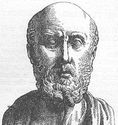 You have been told you have scoliosis and you need to be braced. What next? The first thing you should know is that you’re going to be fine. You’re the same person today that you were yesterday, and you are going to stay that way. I often wish we could skip the first month. The reason for this is because once you know what is happening, you realize it’s not the end of the world. The process of making your scoliosis brace is actually very interesting. Let’s go step by step on how this is going to happen. When you come to our office, you will meet one of our orthotist. An orthotist is a person who has studied making braces. First thing, we’re just going to sit and talk about scoliosis. We are going to turn you into a scoliosis genius.
You have been told you have scoliosis and you need to be braced. What next? The first thing you should know is that you’re going to be fine. You’re the same person today that you were yesterday, and you are going to stay that way. I often wish we could skip the first month. The reason for this is because once you know what is happening, you realize it’s not the end of the world. The process of making your scoliosis brace is actually very interesting. Let’s go step by step on how this is going to happen. When you come to our office, you will meet one of our orthotist. An orthotist is a person who has studied making braces. First thing, we’re just going to sit and talk about scoliosis. We are going to turn you into a scoliosis genius.
There are many causes of scoliosis, but if you’re in our office getting a daytime or nighttime brace, you probably have Idiopathic Scoliosis. This basically means that while you do have scoliosis, we really don’t know why. Scoliosis is the Greek word for crooked, and idiopathic means “we really don’t have a clue.” It might help to know a little history about the way scoliosis has been managed.
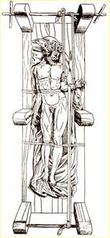 I will assure you that things have never been better in the state of braces that we make for scoliosis control. One of the earliest records of scoliosis management comes from someone you may have heard of, Hippocrates. He studied scoliosis and other problems with the spine about 2500 years ago, and is actually the physician who first used the term scoliosis to describe the condition. Hippocrates also developed methods of treating scoliosis, one of which is pictured here. Even though his device was horrible, and by modern standards totally unacceptable, it was actually very accurate with the points of pressure applied to the spine. As a matter of fact, modern braces de-rotate and straighten the spine following the same principles. Not bad for a guy without x-rays, digital imaging, titanium or plastics.
I will assure you that things have never been better in the state of braces that we make for scoliosis control. One of the earliest records of scoliosis management comes from someone you may have heard of, Hippocrates. He studied scoliosis and other problems with the spine about 2500 years ago, and is actually the physician who first used the term scoliosis to describe the condition. Hippocrates also developed methods of treating scoliosis, one of which is pictured here. Even though his device was horrible, and by modern standards totally unacceptable, it was actually very accurate with the points of pressure applied to the spine. As a matter of fact, modern braces de-rotate and straighten the spine following the same principles. Not bad for a guy without x-rays, digital imaging, titanium or plastics.
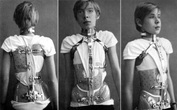 Let’s move ahead to the 1940’s. The first modern attempt at bracing brought the development of the Milwaukee brace. The Milwaukee brace consisted of a pelvic girdle and a metal superstructure for the placement of straps and pads. There was also a neck ring that was actually designed to hurt you if you rested against it. The brace was worn for 23 hours a day until grown. For most users, the brace did not come off until high school graduation. That would usually be from age 13 to 18.
Let’s move ahead to the 1940’s. The first modern attempt at bracing brought the development of the Milwaukee brace. The Milwaukee brace consisted of a pelvic girdle and a metal superstructure for the placement of straps and pads. There was also a neck ring that was actually designed to hurt you if you rested against it. The brace was worn for 23 hours a day until grown. For most users, the brace did not come off until high school graduation. That would usually be from age 13 to 18.
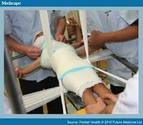 The process began with the patient being placed on a device called a Risser table. Straps were placed around the pelvis and arms. The ends of the straps were attached to a ratchet device and the patient was stretched. Then casting material was wrapped around the torso and a mold was made. The “rack” is no longer used. Unlike the device made by Hippocrates, the Milwaukee brace was at least portable. Studies of the Milwaukee brace and its effectiveness did indicate that it altered the natural history of scoliosis. Basically, people who wore the brace had much better outcomes than people who did not.
The process began with the patient being placed on a device called a Risser table. Straps were placed around the pelvis and arms. The ends of the straps were attached to a ratchet device and the patient was stretched. Then casting material was wrapped around the torso and a mold was made. The “rack” is no longer used. Unlike the device made by Hippocrates, the Milwaukee brace was at least portable. Studies of the Milwaukee brace and its effectiveness did indicate that it altered the natural history of scoliosis. Basically, people who wore the brace had much better outcomes than people who did not.
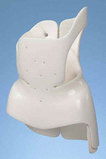 The next advancement came in the 1970’s with the development of the Low Profile Boston brace. This was a great improvement over the Milwaukee brace. The Low Profile had no parts that protruded from the clothing. The neck ring was gone along with the outriggers and straps. The brace was very close fitting and with a few good clothing choices, it would pretty much disappear.
The next advancement came in the 1970’s with the development of the Low Profile Boston brace. This was a great improvement over the Milwaukee brace. The Low Profile had no parts that protruded from the clothing. The neck ring was gone along with the outriggers and straps. The brace was very close fitting and with a few good clothing choices, it would pretty much disappear.
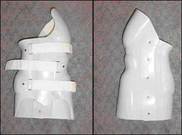 Finally, in the 1990’s, advancement was made that really did alter the method of treating idiopathic scoliosis. The first night bending brace was developed. The Charleston bending brace signaled the end to daytime brace wear. The concept came about with the question, what would happen if we attempted to bend the curve in the opposite direction? Would it be possible to wear the brace fewer hours and still get the same results as the Milwaukee and Low profile braces? After years of study, the answer came back and it was yes.
Finally, in the 1990’s, advancement was made that really did alter the method of treating idiopathic scoliosis. The first night bending brace was developed. The Charleston bending brace signaled the end to daytime brace wear. The concept came about with the question, what would happen if we attempted to bend the curve in the opposite direction? Would it be possible to wear the brace fewer hours and still get the same results as the Milwaukee and Low profile braces? After years of study, the answer came back and it was yes.
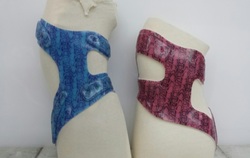 Now that you know how we arrived at the current state of the art, what will your experience be like when you arrive at Owens Carolina? We very seldom make a traditional type of cast. Instead, a 3d digital image will be taken. We use a scanning device that only requires about 15 seconds to collect the data. Casting takes about one hour. Having collected the data that allows us to make your brace, you leave our office. Using your x ray, we will modify the image so that the brace will push in all the right places. Once we have prepared the 3d image, we send the file to our carver, and your shape is carved from a block of foam. When the carver is finished making the model, plastic is vacuumed to the shape. From there, we remove the plastic from your model, trim it, add pads and then put on closures.
Now that you know how we arrived at the current state of the art, what will your experience be like when you arrive at Owens Carolina? We very seldom make a traditional type of cast. Instead, a 3d digital image will be taken. We use a scanning device that only requires about 15 seconds to collect the data. Casting takes about one hour. Having collected the data that allows us to make your brace, you leave our office. Using your x ray, we will modify the image so that the brace will push in all the right places. Once we have prepared the 3d image, we send the file to our carver, and your shape is carved from a block of foam. When the carver is finished making the model, plastic is vacuumed to the shape. From there, we remove the plastic from your model, trim it, add pads and then put on closures.

